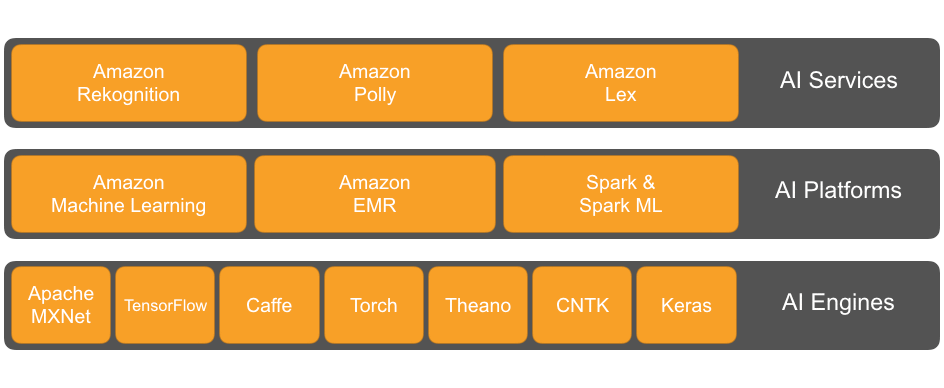Artificial Intelligence
Welcome to the New AWS AI Blog!
If you ask 100 people for the definition of “artificial intelligence,” you’ll get at least 100 answers, if not more. At AWS, we define it as a service or system which can perform tasks that usually require human-level intelligence such as visual perception, speech recognition, decision making, or translation. On this new AWS blog, we’ll be covering these areas and more, with in-depth technical content, customer stories, and new feature announcements.
The challenges related to building sophisticated AI systems center mostly around scale: the datasets are large, training is computationally hungry, and inferring predictions can be challenging to do at scale or on lower-power and mobile devices. Customers have been using AWS to solve these general problems for years, and the ability to be able to access storage, GPUs, CPUs, and IoT services on demand has emerged as a perfect fit for intelligent systems in production. AWS has become the center of gravity for AI, both at Amazon and for AWS customers.
From computer vision systems for autonomous driving, to FDA-approved medical imaging, AWS has driven innovation in existing products or helped define entirely new categories of products for customers such as Netflix, Pinterest, Airbnb, GE, Capital One, and Wolfram Alpha. It’s also used extensively at Amazon to decrease order delivery time with robotic fulfilment, to create novel features such as X-ray (showing themes, characters, and their interactions in video and text), or to bring new experiences to life such as Amazon Echo, Alexa, or the new deep learning-powered, line-free, checkout-free grocery store, Amazon Go (currently in beta testing in Seattle).
Our vision is to use the expertise and lessons learned from customers and the thousands of engineers focused on AI at Amazon to put intelligence in the hands of as many developers as possible, and that AI should be available to everyone, irrespective of their level of technical skill or ability. Today, our approach breaks down into three main layers which all sit on top of the AWS infrastructure and network. We call this, collectively, “Amazon AI.”

At the highest level, for developers who don’t currently possess the technical skills required to implement AI models, or who lack the high-quality, “ground truth” data to train them, we provide AI services: Amazon Rekognition for image and facial analysis, Amazon Polly for text-to-speech, and Amazon Lex, an automatic speech recognition and natural language understanding service for building conversational chat bots. No deep learning expertise needed here: just visit the AWS console to get started.
One level down, for customers with existing data who want to build custom models, we provide a set of AI platforms which remove the undifferentiated heavy lifting associated with deploying and managing AI training and model hosting: Amazon Machine Learning (with both batch and real-time prediction on custom linear models) and Amazon EMR (with Spark and Spark ML support).
Finally, we provide AI engines, a collection of open-source, deep learning frameworks for academics and data scientists who want to build cutting edge, sophisticated intelligent systems, pre-installed configured on a convenient machine image. Engines such as Apache MXNet, TensorFlow, Caffe, Theano, Torch, and CNTK provide flexible programming models for training custom models at scale. Our favorite, and the deep learning engine of choice at Amazon, is Apache MXNet, which scales almost linearly across hundreds of GPUs, training efficient models which can be run anywhere from new, custom Intel processors and field-programmable gate arrays (FPGAs) on Amazon EC2, to AWS Lambda, to embedded devices on robots and drones.
Whether you’re in academia at the cutting edge of AI research, or are a developer seeking simple ways to add intelligence to your app, Amazon AI provides the broadest set of AI services, backed by a world-class scientific and engineering team.
Today, AI is a hot topic, relevant to the majority of developers (Mark Cuban recently talked about it as the most important technology to ramp up on, to avoid becoming a “dinosaur”), but it’s still very early in the advent of AI. In this blog, we’ll explore AI through tutorials, guidance, best practices, and tips and tricks.